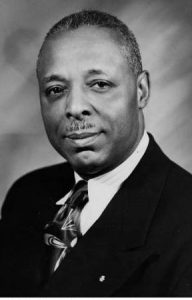
Photo info ...
(Nov. 16, 1886-Mar. 24, 1974). Born in Phoebus, Virginia, and encouraged by his parents to get an education, Robert Brokenburr worked his way through Hampton Institute, graduating in 1906. He then attended Howard University, obtaining a degree in law in 1909. Brokenburr came to Indianapolis in the fall of 1909, having learned of opportunities from publisher . He gained admission to the bar in 1910.

As an attorney Brokenburr successfully pled landmark cases challenging segregation in housing and theaters. He also served as counsel, general manager, and chairman of the board of the Manufacturing Company. From 1919 to 1931 Brokenburr held office as deputy prosecuting attorney, 19th Circuit of Indiana. He also served as judge pro tem in local courts and was a member of the Indiana Fair Employment Practices Advisory Board.
Brokenburr campaigned unsuccessfully for the Indiana House of Representatives in 1912, 1932, and 1934. In 1940 he ran as the nominee for Indiana Senate and won the seat. His election made him the first African American senator in the Indiana legislature. He was elected to four additional terms in 1944, 1952, 1956, and 1960, serving a total of 20 years before retiring from the General Assembly in 1964. During his tenure as state senator he authored bills that prohibited discrimination in employment, public accommodations, and education, as well as an act that established the Indiana Civil Rights Commission.
Brokenburr was an active participant in civic affairs, with affiliations that included the , the , and . He was a member of Jones Tabernacle AME Church. In 1955, President Dwight Eisenhower appointed him alternate delegate to the United Nations.
Brokenburr Trails, a public housing community at 2300 Perkins Avenue built in the 1960s, was named in his honor. The complex was demolished in 2003 and replaced with a development of houses and apartments called Red Maple Grove under the auspices of the Indianapolis Housing Authority.
FURTHER READING
- “Robert Lee Brokenburr Papers and Photographs, ca. 1937–1973.” Manuscript and Visual Collections Department, William Henry Smith Memorial Library: Indiana Historical Society, August 2010. https://indianahistory.org/wp-content/uploads/robert-lee-brokenburr-papers-and-photographs.pdf.
- Warren, Stanley. “Senator Robert L. Brokenburr: He Lived to Serve,” Black History News and Notes no. 83 (2001): 4. https://images.indianahistory.org/digital/collection/p16797coll66/id/19/rec/1.
CITE THIS ENTRY
APA:
Cravey, G. (2024). Robert Lee Brokenburr. Encyclopedia of Indianapolis. Retrieved Jan 4, 2026, from https://indyencyclopedia.org/robert-lee-brokenburr/.
MLA:
Cravey, Georgia. “Robert Lee Brokenburr.” Encyclopedia of Indianapolis, 2024, https://indyencyclopedia.org/robert-lee-brokenburr/. Accessed 4 Jan 2026.
Chicago:
Cravey, Georgia. “Robert Lee Brokenburr.” Encyclopedia of Indianapolis, 2024. Accessed Jan 4, 2026. https://indyencyclopedia.org/robert-lee-brokenburr/.

Help improve this entry
Contribute information, offer corrections, suggest images.
You can also recommend new entries related to this topic.